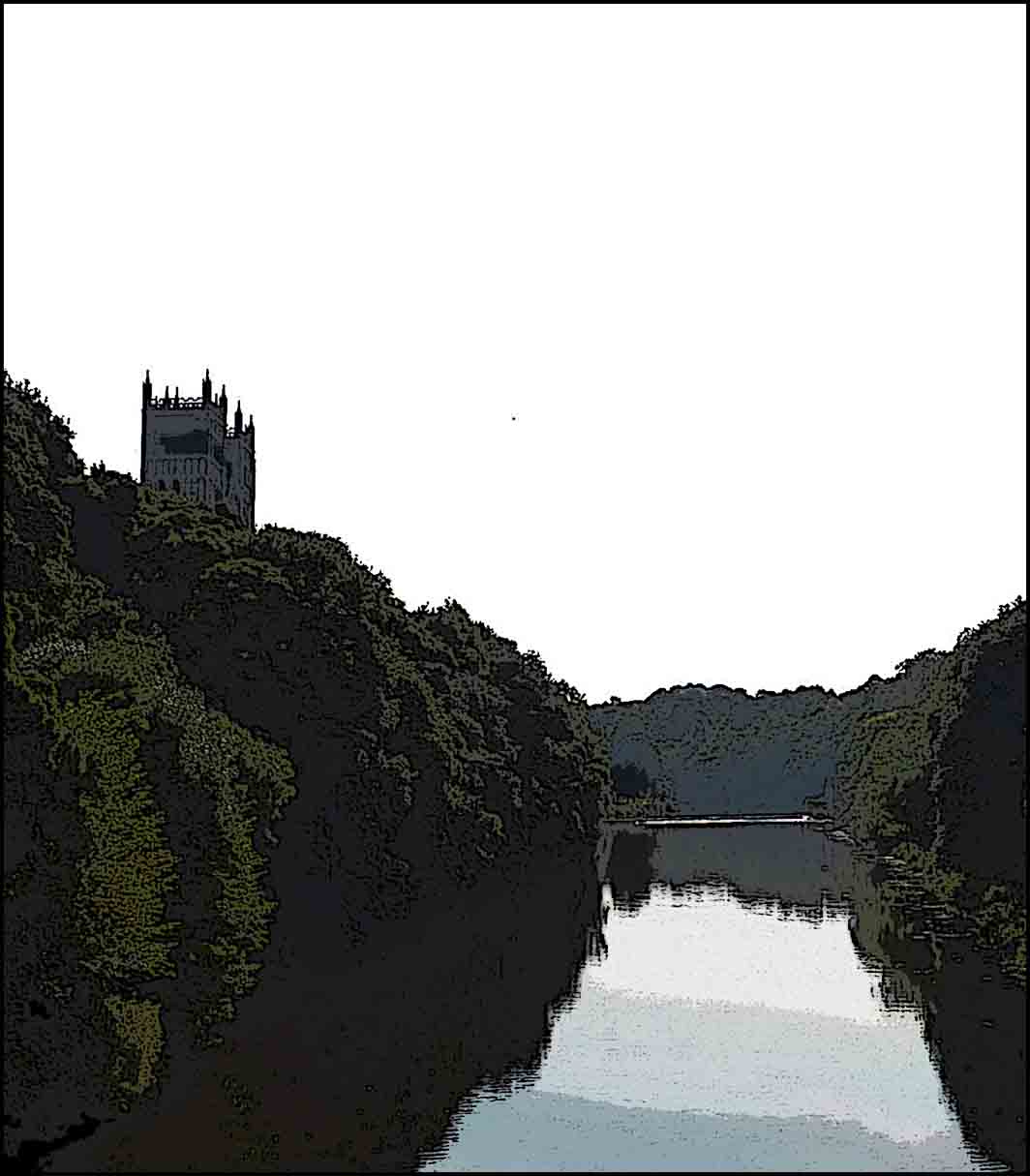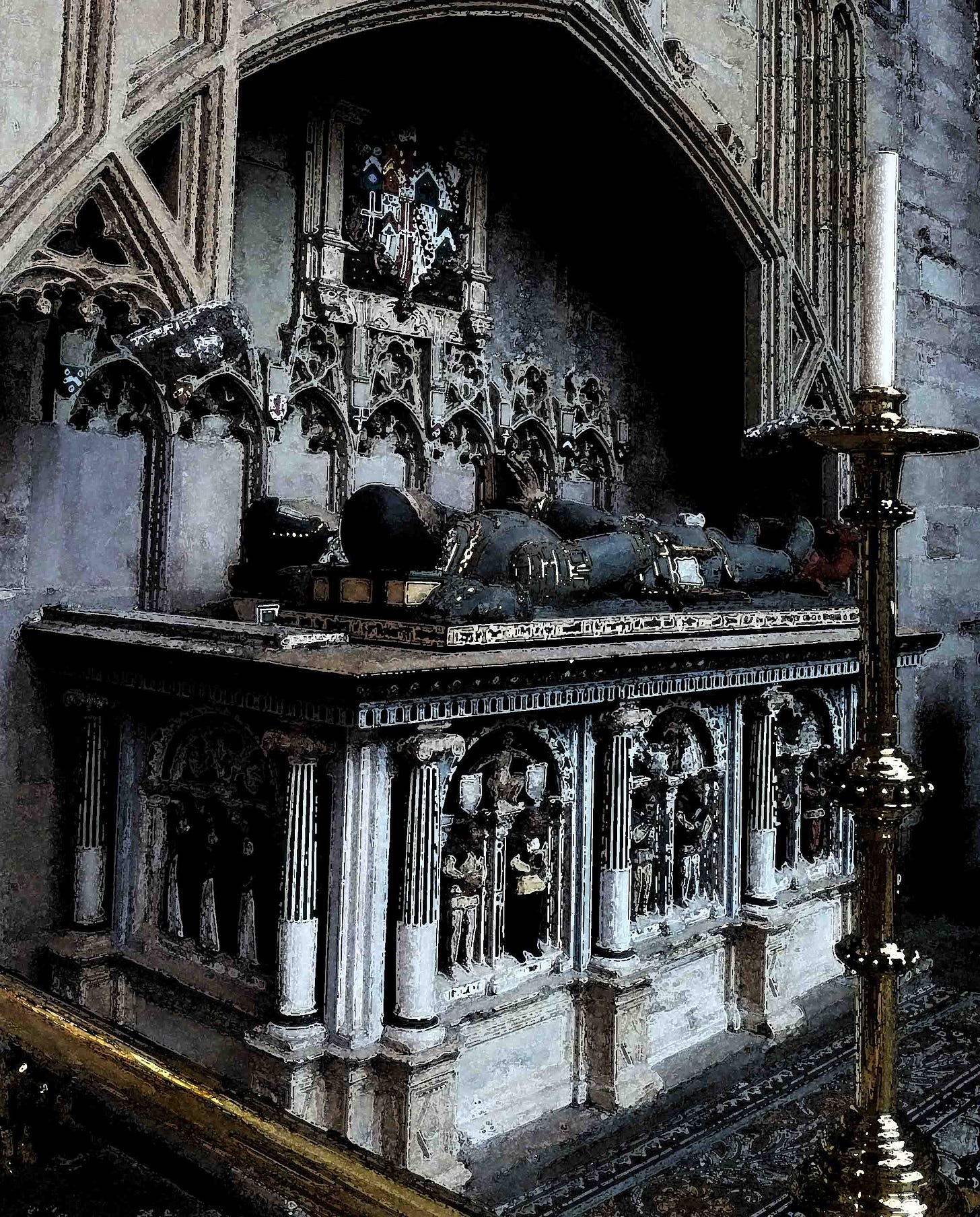I don’t have a picture of Worthen or even Arundel, but here’s an impression of Durham Cathedral from the river. And there’s one from the ‘Cathedral of the Marches’ below.
I was thinking of combining these three rhymes into some sort of musical form, but at the moment the musical project is too rudimentary to publish. Still, I thought some people might find the barebones text and backstory of interest. Don’t feel you have to tell me if I’m wrong. 😉 or at least keep it polite… On the other hand, if you’ve seen Effigies attributed to someone else, I’d certainly like to know if I’ve unintentionally plagiarized it.
Epitaph 1: Thomas Davies
From a thread on the group Memories of Shropshire. The legendary Shroppiemon posted this snippet from a Victorian periodical.
SEPTEMBER 22, 1880.
QUAINT EPITAPH.
The following quaint epitaph is to be seen in Worthen churchyard, upon the tombsone erected to the memory of Thomas Davies, who died 30th December, 1797, aged 59 years :-
This world's a city full of crooked streets,
Death's the market-place, where all mankind must meet;
If life was merchandize that men could buy,
The rich would always live, but the poor must die.
S.M.M.
This was my response:
The first two lines from the epitaph are from – or at least closely resemble lines featured in – 'The Two Noble Kinsman', attributed to Fletcher and Shakespeare.
'This world's a Citty full of straying Streetes,
And Death's the market place, where each one meetes.'
The last two lines aren't in the copy of the play I have, but they do seem to have been around for ages. There are variations on the same couplet in various versions of the spiritual 'All My Trials', which may date from before the American Civil War.
If [religion ¦ a legend living] [was
¦were] a thing that money could buy
The rich would live and the poor would die
Versions of the same four lines seen in the epitaph seem to have been used on various gravestones in England and Scotland, going back to the 17th century or earlier.
Epitaph 2: Unknown
In Epitaphs for Country Churchyards (1856), by Augustus John Cuthbert Hare, I also found this in the Appendix:
"On a Thursday I was born,
On a Thursday made a bride,
On a Thursday broke my leg,
And on a Thursday died."Ludlow, Shropshire.
It’s not the most interesting epitaph in the collection, but it is from Shropshire!
Epitaph 3: John Brimley
John Brimley was an organist at Durham Cathedral between 1541 and 1576
At Masses held in the Cathedral at the time of the Rising of the North (1569) – a failed attempt by Catholic nobles to replace Elizabeth the 1st with Mary, Queen of Scots – he played the organ 'in the loft over the quier door' but when called to account, claimed that under compulsion:
“he songe nott hymselff at them, but played at orgaines and dyd dyvers tymes help to singe salvaes at mattyns and evensonge, and plaid on the orgaines and went in procession as others dyd, after the Crosse.’”
His gravestone in the Cathedral’s Galilee Chapel reads:
John Brimleis body here doth li
Who praysed God with hand and voice
By musickes heavenlie harmonie
Dull myndes he maid in God rejoice
His soul into the heavens is lyft
To prayse him stil that gave the Gyft
Obiit Ao.Dni.1576 Octo.13.
I don’t expect any sort of gravestone myself, but if there was, I’d probably want to plagiarize Hilaire Belloc’s inscription.
When I am dead, I hope it may be said:
‘His sins were scarlet, but his books were read.’
But here’s another collection of literary epithets by more significant writers.
Effigies
In fact, I don’t remember writing this, or where1, or why, but I found it in my file of rough notes for further development. I may have seen it elsewhere and just written it down because I liked it, but I’d expect to have noted the source, in that case. Messrs Google, Duck Duck Go and Google AI (no, I didn’t ask for its input) have failed to find it elsewhere. (If you know better, please let me know!)
Assuming that it is, in fact, my own quatrain, perhaps I was thinking of this tomb chest, in St. Laurence’s church, Ludlow, since I lived in Ludlow for several years and loved looking round the church (which also has some fine misericords, as well as a wall memorial to A.E. Housman, many of whose verses I’ve put to music). These effigies are Sir Robert Townshend and his wife, and the figures around the side of the chest are their twelve children.
This is very much a work in progress: well, unfinished rather than in progress… It’s a single verse and a tune that may well change over time, especially since I can’t lay hands on it right now. The verse will almost certainly not be expanded, but it will probably constitute just one section of a larger piece, perhaps featuring one or more of the epitaphs above, with quite a lot of instrumental music.
Once more they lie together
Not an atom's width apart
Where none disturb their slumber
For there is no beating heart
For a rather different (and possibly even gloomier) approach to a similar visualisation, see Philip Larkin's An Arundel Tomb.
I'm not sure if it's coincidental that while I was posting this LinkedIn suggested that I might be interested in a post as Obituaries Editor for a medical journal...
Well, it was very probably the result of visiting a church or cathedral (likely St. Laurence’s church, which isn’t a cathedral but is often called the Cathedral of the Marches). I haven’t considered myself to be a Christian for several decades, but I do enjoy visiting ecclesiastical buildings, especially if they have a long and interesting history.



